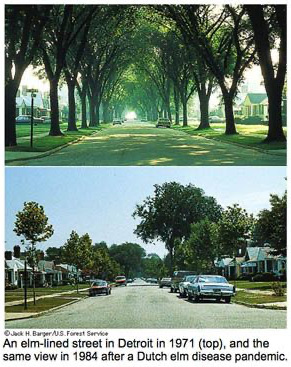A century ago, elegant, vase-shaped American elms shaded neighborhoods with their lacy, arched canopies. Today, many of those trees are dead, skeletal husks—a legacy of the destructive Dutch elm disease. The fungal disease, spread by bark beetles, slowly wiped out most American elms after being introduced in the early 1900s.

However, the American elm’s story isn’t over. Midwest forest health experts are working to stage a comeback, and they need your help. Have you noticed any large, healthy American elms in your area or when out hiking in the forest? Those “survivor elms” might be tolerant of Dutch elm disease. If you are in Michigan’s colder climate zones (zone 5 and colder), you especially are encouraged to report these trees. Currently, there are no Upper Peninsula reports and very few northern lower Michigan reports. It’s important that these zones are represented, because it helps provide a clearer picture of where disease-resistant elms may be.
Several Midwest state natural resource agencies and the U.S. Forest Service are working together to identify such locations. They plan to collect branch samples for propagation (the process of growing new trees from a variety of sources), with the goal of developing a seed orchard suitable for future reforestation efforts in northern areas.
Eligible elms must be:
- An American elm (not an imported species).
- At least 24 inches in diameter.
- Disease-free.
- Naturally grown, not planted or treated with fungicide
- Within 1 mile of Dutch elm disease (indicated by nearby dying/dead elms).
If you come across one of these trees, record its location and diameter at 4.5 feet from the ground. Submit the observation to the survivor elm website.
Ask MG: Why are my elm leaves are turning yellow and wilting?
